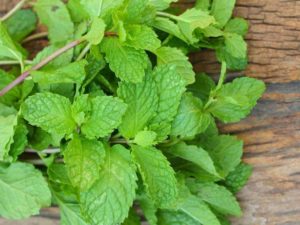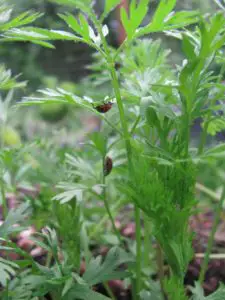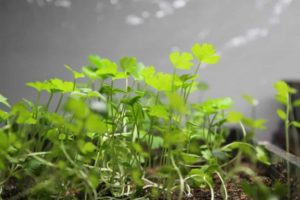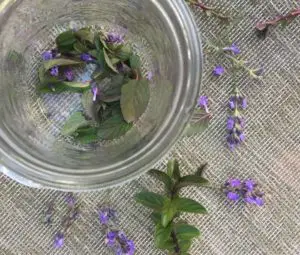Harvesting zinnia seeds from your garden saves you the cost of purchasing new zinnia seeds for the next season.
Since zinnias need to be replanted from seeds each season, saving the parent plant in seed form can save you time, money, and be satisfying to your creativity.
There may even be a surprising mix of zinnia varieties through cross pollination.
Types of Zinnias
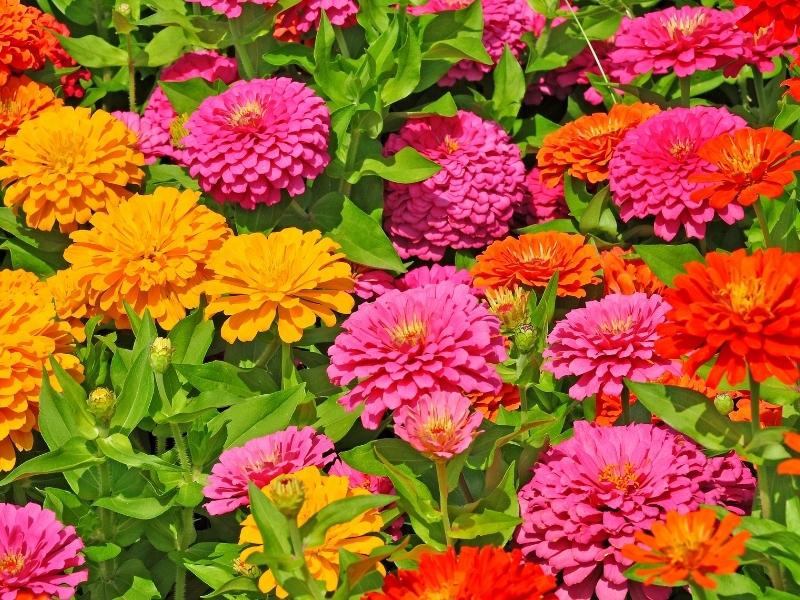
Zinnia seeds all look the same, whether the flower is a hybrid or heritage cultivar.
Zinnia seeds look like arrowheads, and you’ll see them attached to the ends of green or dried petals that are pulled from the flower head.
Open-pollinated zinnias are zinnias grown from original or heritage seeds.
Today, mostly hybrid zinnias are available, which have been created by cross-pollination or intentional pollination in hothouses. Hybrid zinnias have special inbred traits.
The zinnia flower contains two different types of seeds in the petals of the flower or in the florets (at the center of the flower).
The floret zinnia seeds are original heritage seeds that reproduce the parent flower, while the petal zinnia seeds are hybrids which form new variants.
How to Save & Harvest Zinnia Seeds
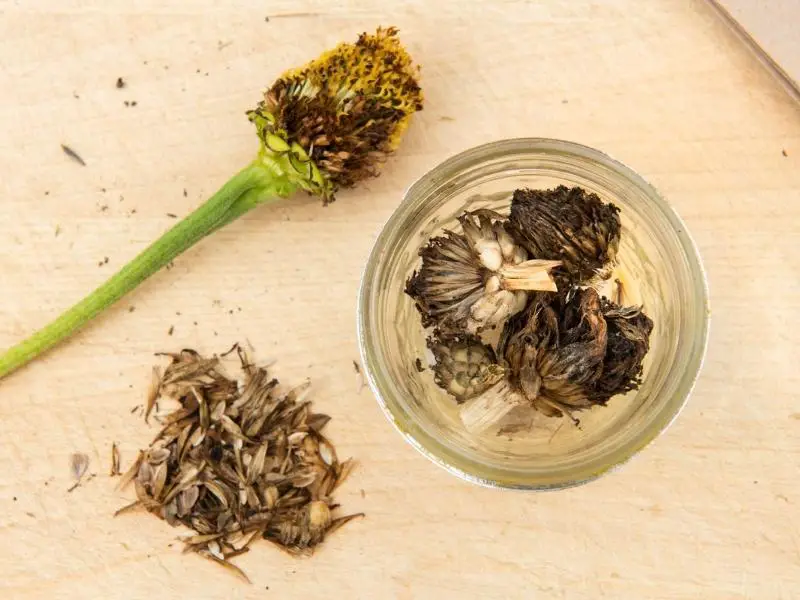
The most important tools and equipment for preserving your own zinnia seeds are:
- A couple of paper packets or paper envelopes
- A pen or pencil to write the zinnia subspecies or description on each packet
- A pair of pliers (optional)
- A large glass jar
- A tray or screen
- Paper towels
The best time to harvest zinnia seeds is when the flower heads have dried on the stems and the last petals have browned or fallen off.
Harvesting time is usually late summer or fall when the flowers have begun to wither and become brown.
While it’s possible to harvest green zinnia seeds, it’s not advisable as many of these zinnia seeds will be immature and won’t produce flowers.
1. Collect the Zinnia Seeds
To harvest zinnia seeds, you’ll need the following materials:
- A flat tray or screen to dry the zinnia seeds
- A sharp pruning scissor
- Paper towels, and stockings (optional)
- Fine snipe nose pliers to sort small seeds (optional)
To get seeds from zinnia flowers, follow these steps:
Remove the dried flower heads
Use the sharp scissors or pruning scissors to neatly cut the dried flower heads and gently drop them in a packet or a basket. Be careful not to shake the flowers too much.
If you wish to plant one pure subspecies the following year, be sure to keep that species of zinnia’s seeds separate. Mixing your zinnia flowers will result in a rainbow box, which is also beautiful.
Removing the zinnia seeds
Place a tray lined with paper towels on a desk and work over the tray.
To remove the zinnia seeds, simply take each flower between the thumb and index finger, squeezing gently and moving your fingers in a rotational manner as if you are rubbing a coin.
The dried seeds will dislodge and fall onto the paper towel-lined tray.
If you don’t want to mix hybrids, keep the seeds separate by using a different paper towel for each different zinnia variety.
Once you have all the seeds of one zinnia kind collected on the paper towel, place another paper towel over the first for the next variety.
Zinnia seeds are arrow-shaped, and some may still have the remainder of the dried flower petals attached. Take these between your index finger and thumb, pulling off the petals with the other hand.
Be sure to check whether the zinnia seeds are viable by examining each seed you wish to keep.
If you like, use fine snipe nose pliers to more easily sort tiny seeds that are hard to pick up with your fingers. A zinnia seed with an embryo inside will be fatter than an infertile seed.
2. Dry the Zinnia Seeds
Zinnia seeds are alive. Even though the flower head has dried out, the seeds still contain moisture.
This moisture can cause mold and rot. It’s important to properly dry zinnia seeds to store them for the next season’s planting.
To dry zinnia seeds, follow these steps:
Separate the zinnia seeds
On the paper towel-lined mesh or baking tray, spread out the zinnia seeds so they don’t touch or overlap at all.
If you don’t have a mesh tray, a baking tray with stockings beneath the paper towel helps air to flow under the seeds better.
Drying Time
When drying out the zinnia seeds, follow a slow and steady process. Simply let the seeds air dry rather than attempting to dry them using another, artificial method.
Depending on how much moisture the seeds contain, you may want to let the seeds air dry for a week or two.
Don’t place them in direct sunlight, and keep an eye for opportunistic insects like ants that may wish to steal the seeds.
Flipping zinnia seeds over
After the tops of the zinnia seeds are dry (in 2–4 weeks), flip the seeds over by gently shaking the tray as if you’re making pancakes.
When the seeds have all been flipped over, let them dry out more. The drier parts of the seeds will be lighter in color than the still-moist parts.
Drying seeds some more
Another week or two may be necessary to dry the bottom of the seeds that are now at the top of the tray.
When both sides of the seeds are the same brown shade and the seeds feel lighter than they were when you started, the seeds are properly dried and ready for storage.
3. Store the Zinnia Seeds
When storing the zinnia seeds, it’s important to make sure there are no damp seeds in the collection.
Prevent humidity from spoiling the seeds by storing them in a fridge or other cool, dark place of 32–41°F, and in a paper envelope in an air-tight glass jar.
Put a silica crystal gel pack or a few dry rice grains in the envelope along with the seeds to further ensure the seeds stay dry.
Harvesting Zinnia Seeds Tips
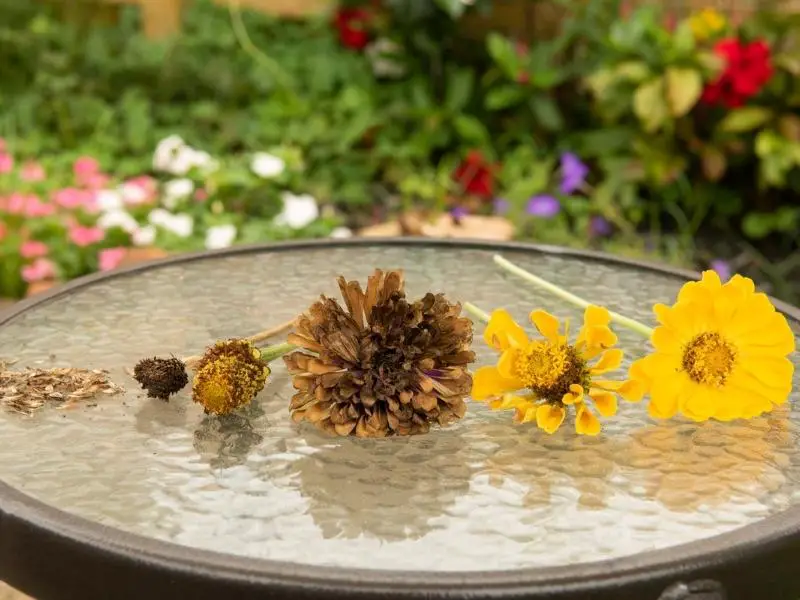
The following tips are helpful in successfully harvesting and preserving zinnia seeds:
Use an Organza Bag
Zinnia seeds can be protected for later harvest by placing an organza bag over the flower while the flower is in full bloom.
Sealing the flower with this breathable organza bag helps protect the seeds from blowing away and even stops cross-pollination.
Deadhead
It’s also a good idea to deadhead or remove the flower heads that come from poorly growing flowers.
Only harvest the best zinnia flowers, as these have the best genetic code in their seeds. Mark the best (growing) blooms during the summer growth season by tying a ribbon around the stems.
Harvest Green
Should inclement weather loom and your zinnia seeds aren’t quite ready for harvest, remember you can harvest green zinnia seeds as long as they are mature enough.
Green zinnia seeds will require a longer time to dry out, and you’ll have to remove the remainder of the dried flower petals from the seeds.
Use stored zinnia seeds within three to five years to ensure the embryo is viable and germination will occur. Leaving seeds for longer may result in a low germination rate.


